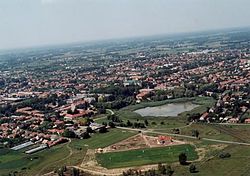Lajosmizse
| Lajosmizse | ||
|---|---|---|

Aerialphotography of Lajosmizse
|
||
|
||
| Location of Lajosmizse | ||
| Coordinates: 47°01′35″N 19°33′28″E / 47.02643°N 19.55776°ECoordinates: 47°01′35″N 19°33′28″E / 47.02643°N 19.55776°E | ||
| Country |
|
|
| County | Bács-Kiskun | |
| Area | ||
| • Total | 164.66 km2 (63.58 sq mi) | |
| Population (2009) | ||
| • Total | 11,053 | |
| • Density | 67/km2 (170/sq mi) | |
| Time zone | CET (UTC+1) | |
| • Summer (DST) | CEST (UTC+2) | |
| Postal code | 6050 | |
| Area code(s) | 76 | |
| Website | http://lajosmizse.hu/ | |
Lajosmizse is a town in Bács-Kiskun county, Hungary. It is located at the end of a railway line from Budapest.
Lajosmizse is situated at the meeting point of routes leading from the North to the South, and from the West to the East. Once the area was covered with groves, then with wind-blown sand. The town stretches over a large area, and is still considered to be a settlement with many outparts. People lived here as early as the Bronze Age, and after the Magyar conquest the area became the dwelling place of the chief's clan. Later it was a crown possession, so the inhabitants could freely graze their livestock on no man's land, that is, on the king's pastures. Around 1246, King Béla IV resettled Cumans whom he called back from Bulgaria, in this area destroyed during the Mongol invasion. Later, in the Turkish times, the Tartar hordes devastated the land in 1596, during the 15-year-war, and the wasteland was leased by the inhabitants of Kecskemét, Nagykőrös and Jászberény for grazing. In 1702 the monarch sold the area to the Teutonic Knights, but the dwellers took joint action and redeemed the lands which had previously been obtained by the Invalides from Pest. This is the origin of the locals' pride in the act of redemption.
The blue is also the colour of transcendence, and conveys the meaning that the mediaeval settlement of Mizse already had a church built of stone, where Franciscan monks were also engaged in converting the reluctant Cumans to Christianity. As soon as the settlement gained independence, its Catholic church was completed by 1896 and, by 1903, the Calvinist church had also been built. The only remaining ruins of the one-time puszta churches are still to be seen here.
The colour green recalls the former grovy pastures, on which in the period of the Magyar conquest, as well as in the Cuman and Turkish times, the breeding of sheep and cattle was dominant; nor can the number of horse herds be underestimated. As long as 1876, Jász-Lajos-Mizse was considered as the undivided pasture of the town of Jászberény. Having gained the rank of municipality in 1876, the settlement began to grow, but on the outer fields the isolated farmsteads kept on flourishing. Even if the forced organization of co-operative farms in the 1950s did bring about changes, following the changing of the political system in 1989, the number of privately owned farms was nearing 4,000. The settlement's industry used to be based on agricultural production (mills, oil presses, etc.), but in the past fifty years various kinds of metallurgical, timber, light, domestic, printing, chemical and meat industry have also appeared, employing part of the population.
...
Wikipedia


